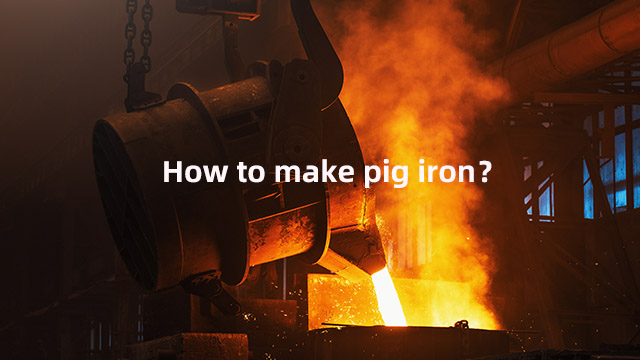How to make pig iron?
2025-02-05 09:46:24 hits:0
The Manufacturing Process of Pig Iron: From Iron Ore to Blast Furnace Smelting

Pig iron is the foundational raw material of the steel industry, produced by smelting iron ore in a blast furnace. It contains a high carbon content and is the starting point for many iron and steel products. The manufacturing process of pig iron involves complex chemical and physical reactions. Below are the key steps and principles of pig iron production.
1. Raw Material Preparation
The production of pig iron requires several key raw materials:
Iron Ore: Primarily composed of iron oxides (such as hematite Fe₂O₃ and magnetite Fe₃O₄).
Coke: Acts as both a fuel and a reducing agent, providing heat and removing oxygen from the iron ore.
Limestone: Serves as a flux, helping to remove impurities (such as silica) from the iron ore and form slag.
Air: Heated in a hot blast stove and blown into the blast furnace to support coke combustion.
These raw materials undergo preprocessing, such as crushing, screening, and sintering, to ensure they are suitable for blast furnace operations.
2. Blast Furnace Smelting
The blast furnace is the core equipment for pig iron production. It is a tall vertical furnace with internal temperatures reaching over 2000°C. The smelting process consists of the following stages:
(1) Charging
Iron ore, coke, and limestone are loaded into the top of the blast furnace in specific proportions, forming layered structures. The coke burns at the bottom, generating high temperatures and reducing gases.
(2) Reduction Reactions
Inside the blast furnace, iron oxides in the ore are reduced by coke and carbon monoxide (CO). The main reactions are:
Coke combustion to produce carbon monoxide:
Carbon monoxide reducing iron ore:
(3) Melting and Separation
The reduced iron melts at high temperatures, forming liquid pig iron. Meanwhile, limestone reacts with impurities (such as silica) in the iron ore to form slag. The slag, being less dense, floats on top of the liquid pig iron, allowing for easy separation.
(4) Tapping Iron and Slag
The blast furnace has tap holes at the bottom for releasing liquid pig iron and slag. The pig iron is sent to steel mills or foundries, while the slag can be used in construction materials.
3. Composition and Properties of Pig Iron
Pig iron primarily consists of iron (about 92%-95%) with a high carbon content (3.5%-4.5%) and small amounts of silicon, manganese, phosphorus, and sulfur. These elements give pig iron the following characteristics:
High hardness but significant brittleness.
Relatively low melting point (around 1150°C-1200°C), making it suitable for casting.
Not directly usable for structural materials; requires further refining or processing.
4. Applications of Pig Iron
Pig iron is mainly used in the following areas:
Raw Material for Steelmaking: Pig iron is a primary raw material for steel production. Through processes like the basic oxygen furnace or electric arc furnace, its carbon content is reduced, and its composition is adjusted to produce various types of steel.
Casting: Pig iron is directly used to cast iron products, such as engine blocks, pipes, and machine tool bases.
Alloy Production: Pig iron serves as a base material for iron-based alloys, used in manufacturing wear-resistant and corrosion-resistant specialty materials.
5. Environmental Protection and Sustainable Development
Traditional blast furnace smelting consumes significant energy and emits carbon dioxide, impacting the environment. In recent years, the steel industry has been exploring more environmentally friendly smelting technologies, such as:
Direct Reduced Iron (DRI): Using natural gas or hydrogen instead of coke to reduce carbon emissions.
Electric Arc Furnaces (EAF): Utilizing scrap steel as raw material to reduce reliance on pig iron.
Carbon Capture and Storage (CCS): Reducing carbon emissions from blast furnace operations.
Conclusion
The production of pig iron is the foundation of the steel industry, and the blast furnace smelting process demonstrates humanity's ability to utilize and transform natural resources. With technological advancements, pig iron production is moving toward greater efficiency and environmental sustainability, providing critical support for the sustainable development of modern industry.
About Tiegu
Tiegau is a professional supplier of pig iron, offering a comprehensive range of products to meet diverse industrial needs. Their product portfolio includes:
Foundry Pig Iron: Ideal for casting applications.
Ductile Iron Pig Iron: Used in the production of ductile iron.
High-Purity Pig Iron: Suitable for specialized applications requiring low impurity levels.
Steelmaking Pig Iron: Designed for use in steel production.
Blast Furnace Pig Iron: A versatile product for various industrial uses.
With a commitment to quality and reliability, Tiegu is a trusted partner in the global iron and steel industry.

 en
en  fra
fra  de
de  ru
ru  gle
gle  th
th  ara
ara  it
it  jp
jp  kor
kor  zh
zh 


